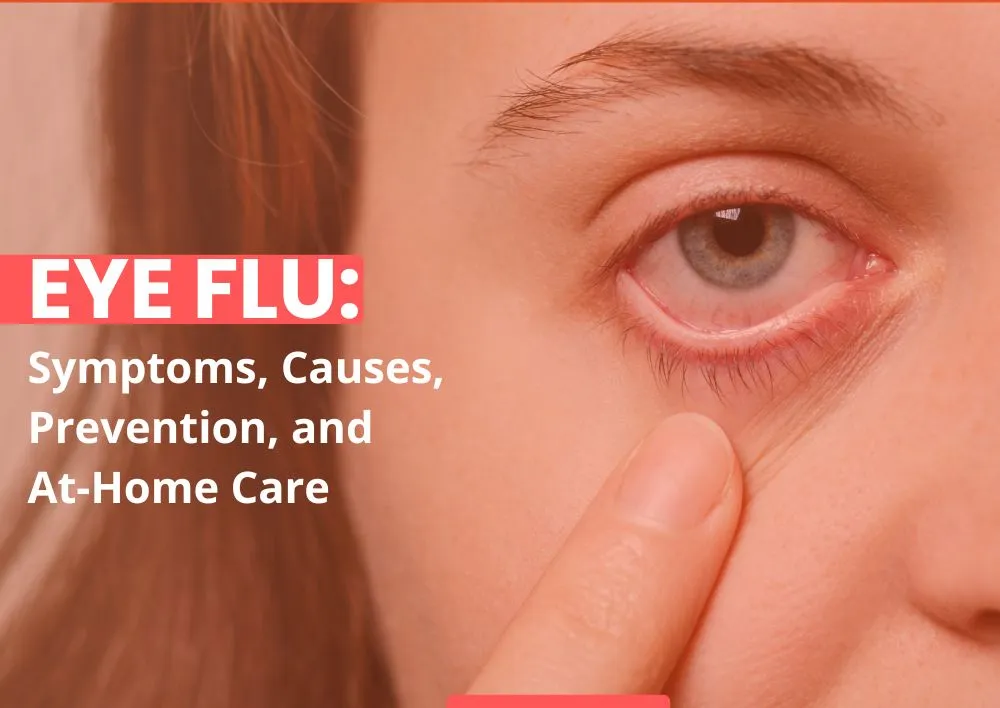Eye Flu: Symptoms, Causes, Prevention, and At-Home Care
In India, seasonal eye allergy (Eye Flu) is a very common occurrence. It affects millions of people from all age groups each year. When airborne allergens are in abundance, eye flu is associated with moderate to severe symptoms including pain, tenderness, itching, etc. But the good thing is that it can be managed effectively with proper care. To stay protected from eye flu, the best mantra is understanding and preventing it. In this blog post, we will discuss the symptoms of eye flu, how to prevent its spread, and ways to care for yourself or a loved one at home if affected. Understanding it can make the lives of affected people a lot better.
Understanding Eye Flu
One of the best ophthalmologists at Miracles Apollo Cradle/Spectra, Gurgaon says that Eye flu, also referred to as pink eye and conjunctivitis is an inflammation of the conjunctiva, the thin and transparent layer of tissue that covers the white part of the eye and lines the inner surface of the eyelids. It can be caused by viruses, bacteria, allergies, or other irritants. Eye flu is highly contagious and spreads easily not only through direct but indirect contact with infected people or contaminated surfaces.
Eye Flu Symptoms
Some Common symptoms of eye flu include:
-
Redness in eyes.
-
Irritation in one or both eyes.
-
Watery eyes.
-
Thick yellow discharge from the eyes.
-
Itchiness
-
Burning sensation.
-
Sensitivity to light.
-
Swelling of the eyelids.
-
Crusty eyelids or lashes, especially in the mornings.
Types of conjunctivitis
Understanding the different types of conjunctivitis is essential for accurate diagnosis and appropriate management. Here are some common types of conjunctivitis:
1. Viral Conjunctivitis: It may affect one or both eyes and is typically caused by adenoviruses, which are highly contagious and can spread through direct contact with infected individuals or surfaces or respiratory droplets.
Symptoms: The symptoms of viral conjunctivitis include watery discharge, redness, irritation, itching, and sensitivity to light.
2. Bacterial Conjunctivitis: It can also affect one or both eyes and caused by bacteria such as Staphylococcus aureus, Streptococcus pneumoniae, or Haemophilus influenzae.Bacterial Conjunctivitis is highly contagious and can spread through direct contact or contact with contaminated objects.
Symptoms: Thick yellow or green discharge, redness, swelling, irritation, and crusting of the eyelids.
3. Allergic Conjunctivitis: It is triggered by allergens such as pollen, dust mites, pet dander, or certain chemicals. Allergic conjunctivitis is not contagious and occurs when the immune system overreacts to allergens.
Symptoms: Itching, redness, watering, swelling, and sensitivity to light. Allergic conjunctivitis may affect one or both eyes and often occurs alongside other allergic symptoms such as sneezing and nasal congestion.
While some types of conjunctivitis, especially viral and bacterial conjunctivitis, require specific treatments, others, like allergic conjunctivitis, focus on managing symptoms and avoiding triggers. If you are experiencing the symptoms, it is important to seek medical advice from an eye specialist near you to determine the underlying cause of conjunctivitis and effective treatment strategies.
Eye Flu Causes
-
Viral Infections: Eye flu is most commonly caused by viruses such as adenoviruses, herpes simplex virus (HSV), enteroviruses, or other respiratory viruses.
-
Bacterial Infections: It is less commonly caused by bacteria such as Staphylococcus aureus, Streptococcus pneumoniae, or Haemophilus influenzae.
-
Allergic Reactions: Eye flu is generally triggered by exposure to allergens like pollen, dust mites, pet dander, or certain chemicals.
-
Exposure to Irritants: Exposure to toxic substances or irritants such as chlorine, smoke, or household chemicals can cause chemical conjunctivitis.
-
Environmental Factors: Environmental factors such as pollution, high pollen counts, dry air, and others can also cause eye flu outbreaks.
-
Close Contact: Coming in direct contact with infected individuals, respiratory droplets, or contaminated surfaces also lead to eye flu.
Eye Flu Prevention
To minimize the risk of seasonal eye flu, adopting preventive measures is important. Here are some preventive strategies:
-
Maintain Good Hygiene: Practice frequent handwashing with soap and water, especially after touching any contaminated surfaces, eyes, mouth, and face. It helps prevent the spread of viral and bacterial infections that can cause eye flu.
-
Avoid Touching Your Eyes: Abstain from touching or rubbing your eyes with dirty hands to avoid introducing viruses or bacteria into your eyes and increasing the risk of infection.
-
Use Protective Eyewear: When outdoors, especially during high pollen seasons, wear protective eyewear or sunglasses to protect your eyes from allergens and airborne irritants.
-
Keep Home Clean: Regularly clean and dust your home to reduce indoor allergens such as dust mites and pet dander, which can trigger allergic reactions and worsen eye flu symptoms.
-
Avoid Close Contact: Avoid meeting individuals with symptoms of respiratory infections, such as coughing, sneezing, or eye redness. Avoiding close contact can reduce the risk of exposure.
-
Consult an Eye Doctor: If you experience constant or severe symptoms of eye flu despite taking preventive measures, seek medical advice from an eye care doctor. They can provide a complete evaluation, accurate diagnosis, and appropriate treatment options.
By following these preventive measures into your daily routine, you can reduce the risk of eye flu and help protect yourself and others from infection.
Self-Care at Home:
While eye flu typically cures on its own within one to two weeks, Here are some eye flu home remedies you can follow to relieve discomfort and promote healing:
-
Apply warm compresses to your eyes for a few minutes several times a day to help relieve irritation and loosen any crusts.
-
Use lubricating eye flu eye drops to keep your eyes moist and relaxed.
-
Avoid wearing contact lenses until your symptoms improve to prevent further irritation.
-
Use over-the-counter antihistamine or decongestant eye drops to help relieve symptoms of itching and redness.
-
Get plenty of rest
-
Drink plenty of fluids to improve your body's immune response.
It is important to consult with an ophthalmologist before using any eye flu medicines.
When to Seek Medical Attention?
While most cases of eye flu can be managed at home, it is important to consult an eye specialist if eye flu treatment at home is not providing you relief or if you have:
-
Severe pain
-
Vision changes.
-
Symptoms that worsen or continue for more than two weeks.
-
Signs of bacterial infection, such as thick yellow or green discharge.
-
Have a weakened immune system.
Eye doctors will conduct medical evaluations, provide personalized advice, and recommend appropriate eye flu treatment based on your condition.
Conclusion:
Eye flu is a common condition that can be managed effectively with proper care and hygiene practices. By recognizing the symptoms, taking preventive measures, and practicing self-care at home, you can help relieve discomfort and prevent the spread of infection to others. Remember to consult with an eye specialist near you if you have concerns about your symptoms of conjunctivitis or if they worsen over time. With patience, you can go through eye flu.
If you are still unable to find the solution for eye flu with home remedies? You should consult an ophthalmologist at Miracles Healthcare, the best eye specialist clinic near you for eye care.














Was the information useful?
0 0